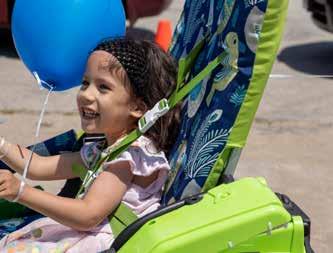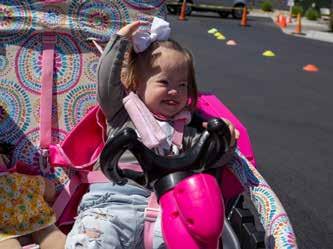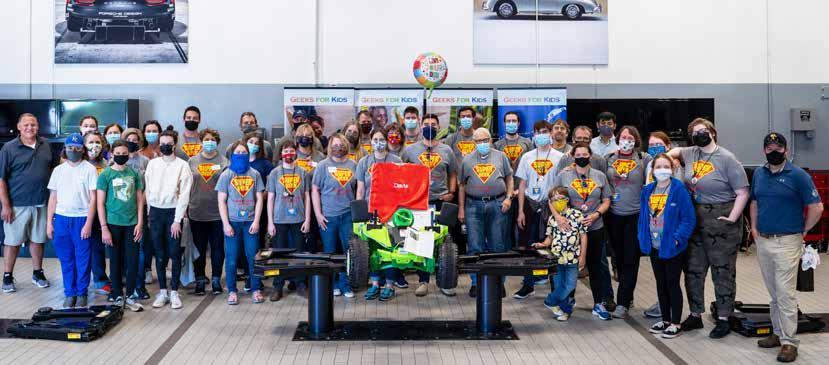
5 minute read
NONPROFIT
Geeks For Kids Puts Kids With Mobility Challenges in the Driver’s Seat.
For kids with mobility challenges, a ride-on toy car can mean so much more than a few minutes of fun: It’s the key to independence, learning, and connection they may otherwise struggle to experience.
Advertisement
Enter LEARN Science & Math Club, a nonprofit providing kids from the Kansas City metropolitan area with rich science and math experiences through the use of robotics, engineering and programming projects, and laboratory experiments.
Rebecca Kidwell, president of LEARN, says a biomedical project undertaken by the organization’s middle school and high school robotics team motivated LEARN to look at other ways to add meaning to the work being done. Then they came across GoBabyGo!, a grassroots initiative out of the University of Delaware that shared details on how to modify ride-on cars for kids with disabilities and encouraged communities around the world to adopt the mission.
In 2017, LEARN students and adult volunteers built a car for a 2-year-old with spina bifida as a test to see if the team would feel excited and inspired by the work. The answer? A resounding, yes. They built a dozen cars the following year, 18 the next, and 30 last year – and in 2021, they’ve built 36 cars, so far.
“For grownups and kids, the reaction universally is, ‘I’m making a difference,’” Kidwell says. “We are changing kids’ lives. It’s incredibly rewarding.”
BEHIND THE BUILDS
Over 500,000 American kids under the age of five have mobility problems, and few have access to devices that give them free movement. Without it, these kids may struggle to grow and learn as their peers do, playing and




interacting with the world around them, and developing strength, coordination, and decision-making skills.
Geeks for Kids adapts off-the-shelf toy cars to meet kids’ unique needs. There’s a version with a “go” button in place of a gas pedal; kids with limited upper-body strength and dexterity can use a model featuring a joystick or control panel; and children with little ability to move their bodies have head control and remote-control options. Each car also includes a variety of features for safety and comfort based on the child’s measurements.
“I try not to wax poetic, but it’s very moving to see a kid – who, oftentimes, hasn’t moved independently, on her own, ever – experience those first minutes of movement and freedom. It is lifechanging for them, and kind of for us, too,” Kidwell says.
Take Jeremiah, a two-year-old who met with the Geeks for Kids team last year. His parents didn’t think he would be able to operate a car by himself, but the team encouraged them to try a joystick during a visit to see what he would respond to.
After getting some measurements in the car, Kidwell helped him push the joystick, and he laughed riotously. They continued the pattern until he was driving on his own – the team was ecstatic, but Jeremiah’s parents were crying.
“They had just learned a couple of weeks before they met us that their toddler had spastic paraplegia and had been working to reconcile themselves to the fact that he might not do the kinds of things that they imagined doing with their child, like go to prom and play baseball,” Kidwell recalls. “That day, they realized he would do things they hadn’t imagined that he would do.”
COMMUNITY POWERED
Geeks for Kids gives all cars to kids for free. Depending on the complexity of the car, each build costs between $750 and $2,175, money the organization raises through direct donations, crowdfunding campaigns, and sponsorships.
Community members play a critical role in the mission, as Geeks for Kids is an all-volunteer organization. Professional techs work with high school and college student roboticists, engineers, and programmers to design and build the cars,

an arrangement that allows students to apply skills they’ve been learning, make innovative decisions, and experience first-hand the difference they can make in the lives of others.
Before the pandemic, the organization also hosted five or six big build events where community members came together to help with a variety of tasks, no technical expertise required. In 2019, Geeks for Kids had 215 volunteers helping to produce the cars. Unfortunately, last year that number dropped to just 11 people doing the bulk of the work.
“We’re really excited to return to normal someday and reengage with our broader community,” Kidwell said, adding, “We need more people – our goal is to do more and more and more, so we need more and more people.”
That includes more people applying for cars. Many families are referred to Geeks for Kids by Children’s Mercy, Ability KC, Advent Health, and other local physical therapy programs for kids, which Kidwell worries might keep families without the financial resources for physical therapy from learning about the program.
“One of our big goals is to break through and make more people aware that we would make a car for their child if they’d like us to,” Kidwell says.
She encourages families to apply for a car even if they’re not sure if existing adaptations would work for them – the Geeks for Kids team is constantly working on new ways to address needs that arise, including a forthcoming prototype designed to accommodate older and taller kids.
To learn more about Geeks for Kids, including how to apply for a car, make a donation or volunteer, visit geeks.learnscienceandmathclub.org.
ABOUT THE AUTHOR
Kelsey Cipolla is a local writer, editor, and social media specialist. Kelsey has covered everything from the Kansas City culinary scene to home design, health, fitness trends, hidden gems, and nonprofit in the Kansas City community.







